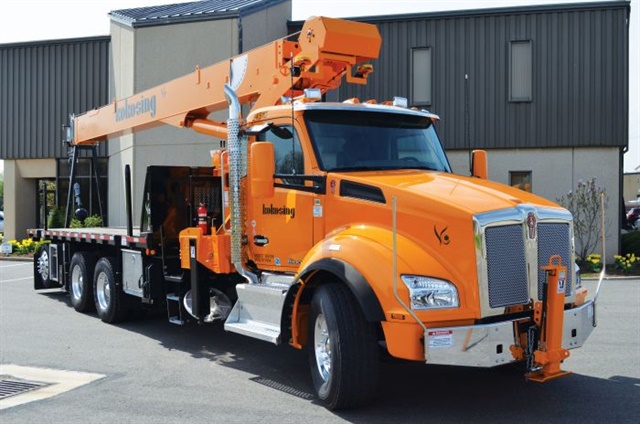Idle Reduction is Key for Ohio Construction Fleet
The newest Kenworths in the construction firm’s fleet are T880s, like this multi-axle flatbed truck with a National 27-ton on-board crane. They carry and lift materials and mechanical equipment at heavy bridge and industrial projects, and engines run hydraulic pumps to operate the cranes. Thus idle-reduction isn’t always possible.
“>
The newest Kenworths in the construction firm’s fleet are T880s, like this multi-axle flatbed truck with a National 27-ton on-board crane. They carry and lift materials and mechanical equipment at heavy bridge and industrial projects, and engines run hydraulic pumps to operate the cranes. Thus idle-reduction isn’t always possible.
“>
How do you save fuel in a work-truck and heavy-haul operation? “Leave the truck parked,” quips Wayne Queen, trucking yard manager at Kokosing Construction, named for a river that flows past its headquarters at Fredericktown, Ohio.
“In the vocational world, [fuel economy] is a tough sell – everything is big, wide and tall. Some trucks run equipment through PTOs, so the engines have to run and it’s hard to save fuel.”
He directly manages 32 Kenworth T800 and T880 trucks and tractors. The latter have Cummins 550- and 600-hp diesels and pull lowboys to move equipment to project sites in Ohio and nearby states. Heavy straight trucks haul materials handled by on-board cranes. They sometimes gross over 70,000 pounds, and loaded tractor-trailers gross 80,000 to 200,000 pounds. So high mpg numbers aren’t likely.
“Idling is our biggest concern and is what we focus on to save fuel,” Queen says. “We tell our drivers, ‘Turn the truck off when you come into the office.’ I see a driver in the hall and look outside and his truck’s running. If I go out and happen to walk by a running truck, I’ll turn it off. Starters are cheap compared to fuel.”
Kokosing also has scores of mechanics’ service trucks whose power take-offs operate various equipment while on assignments. But if the engine isn’t running something through the PTO, turn it off, drivers are told. Many work trucks have diesel-driven electric welding rigs that can also be used to run tools and pumps, and managers tell operators to use those whenever possible.
Route planning works, too. “Combine the routes whenever you can to reduce miles run. Figure out the best route possible for distance and to avoid left turns,” Queen says. “The biggest thing is, educate your drivers, and manage your fleet with knowledge of idle times and ways to avoid it.”
Related: Friendly Competition Helps RRR Drivers Improve MPG
Follow @HDTrucking on Twitter
